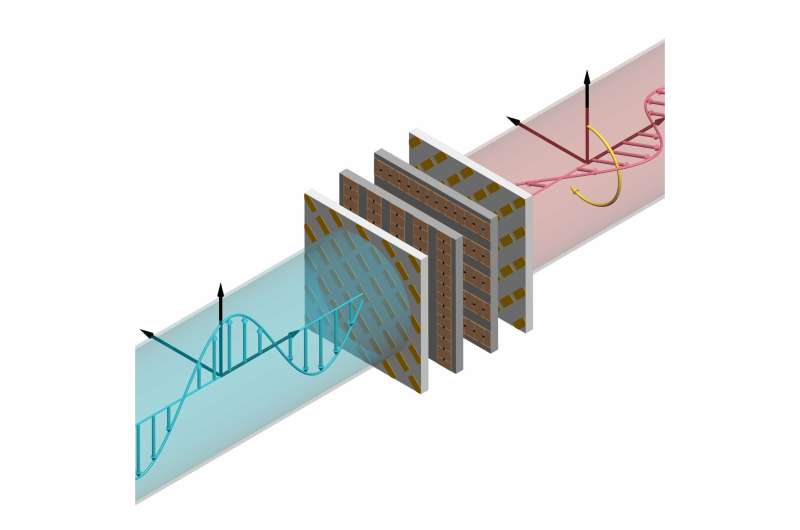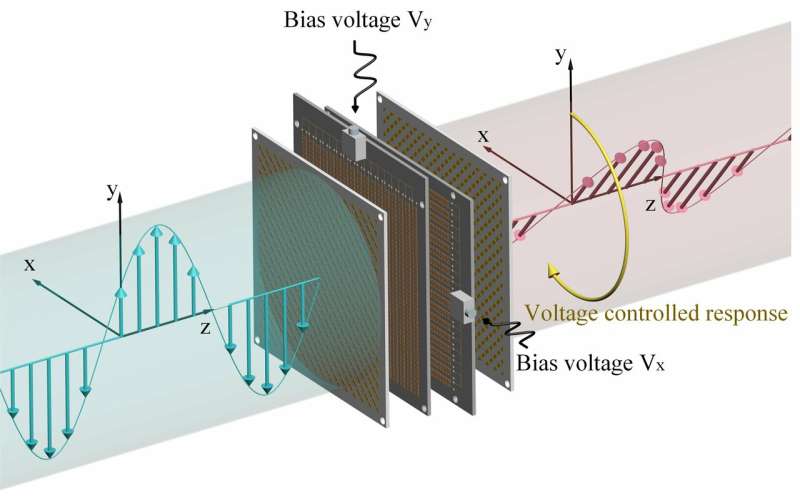March 12, 2019 feature
An electronically tunable metasurface that rotates polarization

Researchers at the University of Michigan and City University of New York have recently proposed and experimentally validated a transparent, electronically tunable metasurface. This metasurface, presented in a paper published in Physical Review X, can rotate the polarization of an arbitrarily polarized incident wave without changing its axial ratio.
Metasurfaces are artificial sheet materials textured at a sub-wavelength scale in order to produce tailored electromagnetic responses. In recent years, these materials have enabled unprecedented control over electromagnetic waves, opening up interesting possibilities in numerous areas, including wireless communications, imaging and energy harvesting.
Despite their numerous advantages, most metasurface designs only offer static functionalities. The new metasurface devised by the researchers, on the other hand, has dynamically tunable properties, and could hence be applied in a broader variety of areas.
"A few years ago, our research group introduced a pragmatic approach to realizing metasurfaces with tailored bianisotropic responses," Zhanni Wu, one of the researchers who carried out the study, told Phys.org. "This approach involves cascading patterned (i.e. anisotropic) metallic surfaces across a subwavelength thickness to achieve targeted electric, magnetic and chiral/omega properties. The technique is amenable to planar micro- and nano-fabrication techniques, allowing realization of metasurfaces from RF to visible wavelengths."
Over the past few years, the same team of researchers designed and realized several metasurfaces, with various functionalities. Although these ultrathin metasurfaces achieved extreme wavefront control, their functionalities remained static and dependent on their fixed geometrical parameters.
"In this work, we integrated tunable devices, varactor diodes, into a metasurface to achieve dynamic control over the metasurface's response," Wu explained. "We demonstrated a transparent metasurface with a tunable chiral response, which can rotate the polarization of an incident wave."

Manipulating the properties of electromagnetic waves (e.g. amplitude, phase and polarization) typically involves a combination of optical components, such as lenses, polarizers and waveplates. The new metasurface introduced by the researchers has a polarization rotator, which consists of a tunable birefringent structure sandwiched between two ±45° rotated metasurface-based quarter-wave plates.
"A conventional tunable polarization rotator is typically multiple wavelengths in size (tens to hundreds) and consists of two rotated quarter wave plates (linear to circular polarizers) placed on either side of a tunable birefringent medium, like a liquid crystal layer," Anthony Grbic, another researcher who carried out the study, told Phys.org. "Here, we have replaced this bulky device with a cascade of metasurfaces, resulting in a device of subwavelength thickness and equivalent functionality."
The approach demonstrated by Wu, Grbic and their colleague Younes Ra'di enables ultra-compact designs and could be applied in microwave polarimetric systems for the characterization or detection of objects. For instance, their metasurface-based polarization rotator could be integrated with an antenna element to develop a compact antenna system for polarimetric microwave imaging.
"Our work paves the way for flat/low profile, dynamically tunable antennas and optical/quasioptical systems," Grbic said. "One can envision replacing bulky electromagnetic or optical setups requiring combinations of conventional components including lenses, tuning elements, phase shifters, spatial light modulators, waveplates, linear polarizers simply with cascaded ultra-thin, tunable metasurfaces."
The recent study carried out by Wu, Grbic and Ra'di introduced a novel platform that enables full control of the transmitted wave front. The researchers demonstrated their approach by developing a tunable polarization rotator, yet it could also be used to tailor reflected waves. In the future, their method could hence be applied to the design of a tunable metasurface that not only rotates the polarization of the reflected/transmitted wave, but also steers a beam into different directions.
"Our future research plans also include the development stacked metasurface designs for tunable amplitude control, in addition to the phase/polarization control we have demonstrated to date," Ra'di told Phys.org. "A further goal of ours is to translate such metasurface designs to optical wavelengths."
More information: Zhanni Wu et al. Tunable Metasurfaces: A Polarization Rotator Design, Physical Review X (2019). DOI: 10.1103/PhysRevX.9.011036
Carl Pfeiffer et al. Bianisotropic Metasurfaces for Optimal Polarization Control: Analysis and Synthesis, Physical Review Applied (2014). DOI: 10.1103/PhysRevApplied.2.044011
Journal information: Physical Review X
© 2019 Science X Network




















